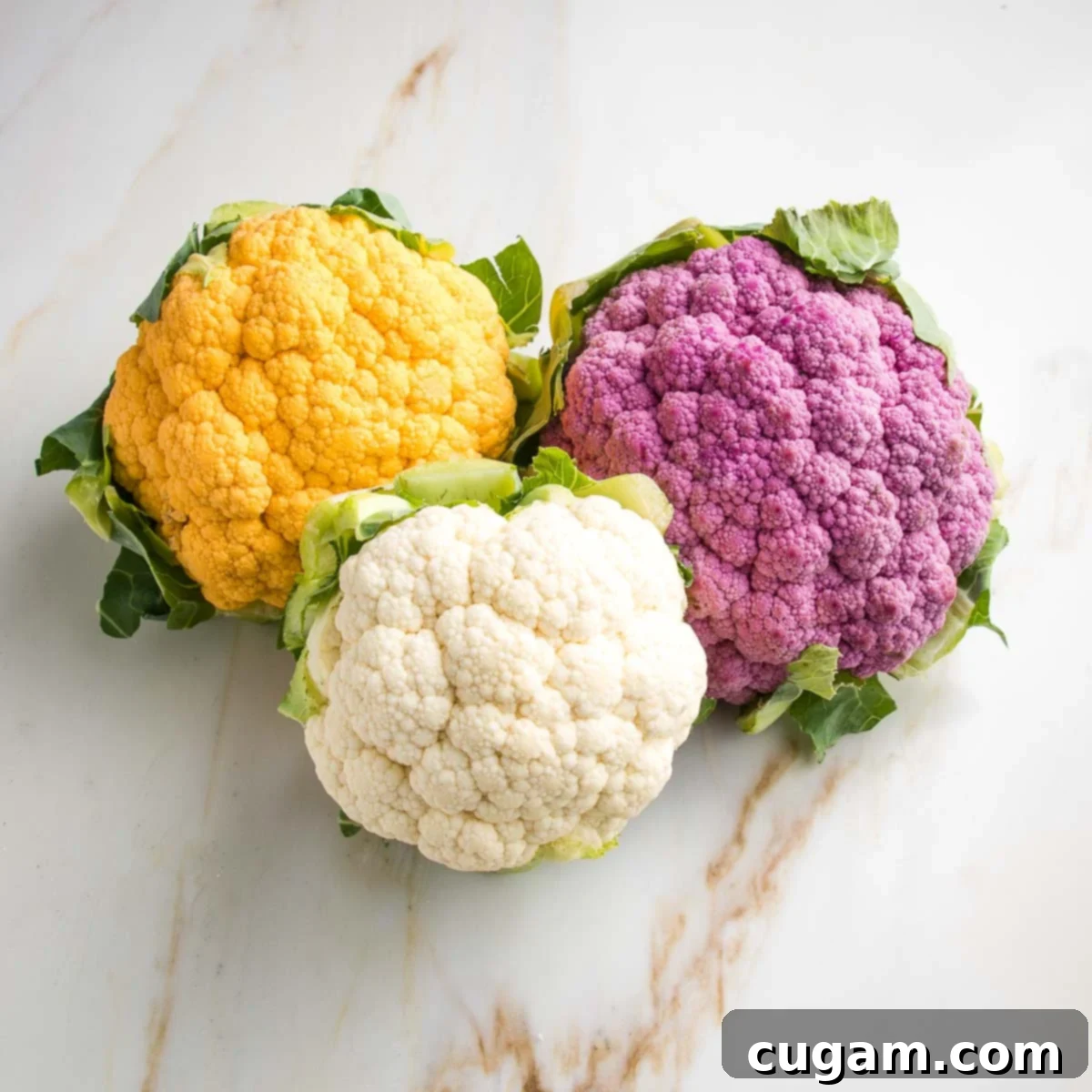The Ultimate Guide to Cauliflower: Delicious Recipes, Incredible Health Benefits & Perfect Pairings
Cauliflower is truly a culinary marvel – a vegetable that is not only packed with nutrients but also incredibly versatile, transforming effortlessly into a myriad of dishes. Whether you’re a seasoned chef or just beginning your journey with this amazing vegetable, you’re in for a treat. This comprehensive guide will explore the best ways to prepare cauliflower, offer delicious pairing ideas, and delve into its impressive health benefits. Get ready to discover your new favorite ways to enjoy cauliflower!
From hearty main courses to delightful side dishes and even innovative grain substitutes, cauliflower’s mild flavor makes it a perfect canvas for countless spices and essences. It’s a true people-pleaser, adapting to whatever culinary vision you have in mind. You can enjoy it raw for a crisp bite or cook it using various techniques like roasting, steaming, mashing, or ricing to achieve different textures and flavor profiles.
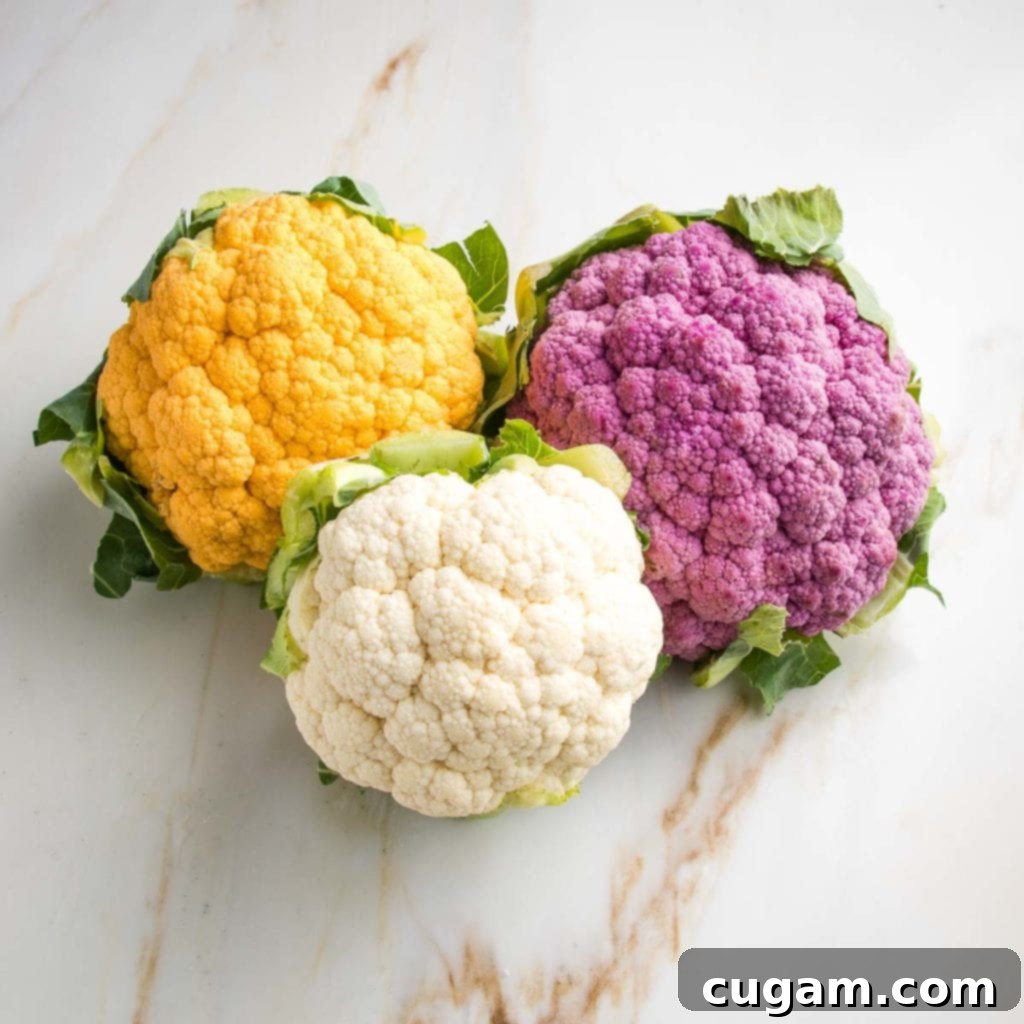
This post may contain affiliate links. As an Amazon Associate, I earn from qualifying purchases at no additional cost to you.
How to Buy and Store Cauliflower Like a Pro
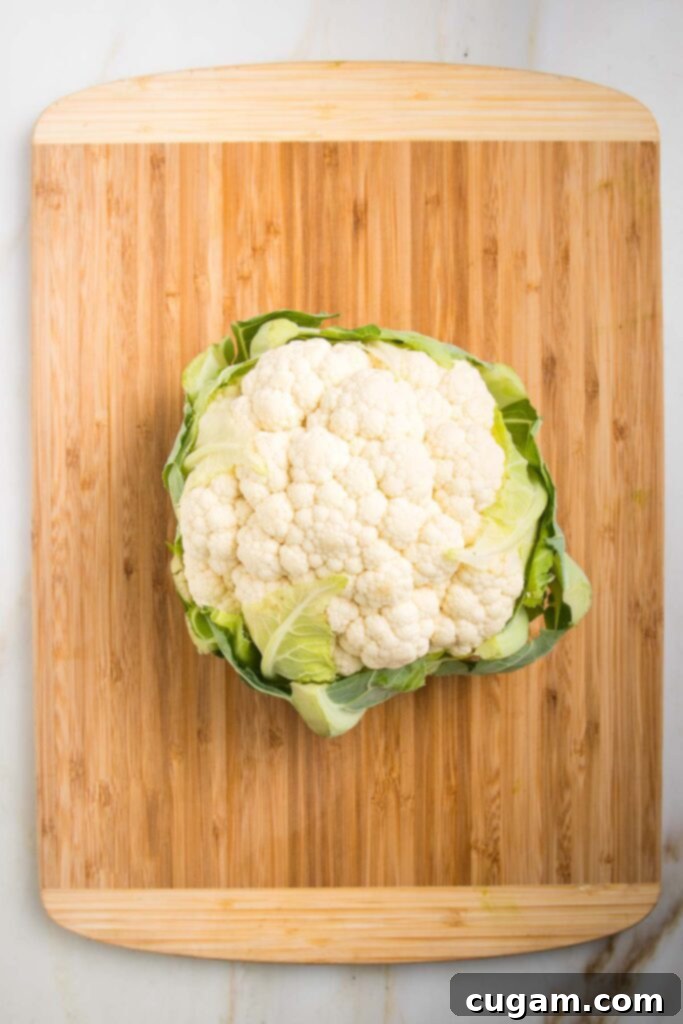
Choosing the freshest cauliflower is key to enjoying its best taste and texture. Follow these tips to select and store your cauliflower effectively:
- Source Locally: Fresh cauliflower can be found in local farmers’ markets, grocery stores, and larger retail outlets. Opting for local produce often means it’s fresher and hasn’t traveled as far.
- Inspect the Florets: Look for cauliflower with densely packed florets. They should be firm to the touch, indicating freshness. Avoid heads with noticeable gaps or soft spots, which suggest it’s past its prime.
- Check for Blemishes: The surface of the cauliflower should be uniformly white (or purple/yellow, depending on the variety), creamy, and free from any brown spots, wet patches, or discoloration. Small brown spots can be trimmed, but widespread discoloration is a sign of spoilage.
- Examine the Leaves: The outer leaves of the cauliflower head are a great indicator of its freshness. They should be crisp, bright green, and firmly attached. Wilted, yellowing, or detached leaves are a clear sign that the cauliflower is older and may lack flavor.
- Optimal Storage: To maximize freshness, store a whole head of cauliflower in an unsealed plastic bag in the refrigerator’s crisper drawer. An unsealed bag allows for some air circulation while preventing moisture loss.
- Combat Moisture: To further extend its shelf life (up to 2 weeks), insert a paper towel into the bag with the cauliflower. The paper towel will absorb any excess moisture, preventing it from settling on the vegetable and accelerating spoilage. Replace the paper towel if it becomes overly damp.
If you’re on the hunt for healthy cauliflower dishes that taste incredible, you’ve certainly come to the right place. For example, an easy cauliflower rice with asparagus recipe could be just the wonderful, nutrient-dense side dish you’ve been searching for to complement any meal.
Next time you’re seeking a show-stopping vegan centerpiece, perhaps for a holiday dinner or a special gathering, whole roasted cauliflower is not only incredibly easy to prepare and profoundly tasty but also strikingly impressive on the dinner table. It’s a fantastic alternative to traditional roasts.
Perhaps your primary question is what to serve with cauliflower? Oh, I have a plethora of delicious ideas for you! Imagine serving a rich vegan mushroom stroganoff over a fluffy, simple cauliflower rice for a comforting, grain-free meal. Or, prepare a nutrient-dense vegan shepherd’s pie for dinner and pair it with a light and refreshing roasted cauliflower salad. The pairing possibilities are truly endless, so keep reading as I’m confident you’ll discover the perfect match to elevate your culinary creations.
Top Health Benefits of Cauliflower: A Nutritional Powerhouse
Beyond its versatility in the kitchen, cauliflower is celebrated for its impressive array of health benefits. This cruciferous vegetable is truly a powerhouse of nutrition, contributing significantly to overall well-being. Here’s a closer look at what makes cauliflower so good for you:
- Rich in FIBER: Cauliflower is an excellent source of dietary fiber, which is crucial for digestive health. Fiber helps maintain regular bowel movements, preventing constipation and promoting a healthy gut microbiome. It acts as fuel for beneficial gut bacteria, which in turn helps reduce inflammation throughout the body, improves nutrient absorption, and lowers the risk of various chronic diseases, including heart disease and certain cancers.
- High in VITAMIN C: Just one serving of cauliflower provides a significant amount of Vitamin C, a powerful antioxidant vital for immune function. Vitamin C supports the production of white blood cells, which are essential for fighting off infections. It also plays a key role in collagen synthesis, contributing to healthy skin, bones, and blood vessels.
- Packed with ESSENTIAL MINERALS: This humble vegetable is a good source of several important minerals, including Potassium, Calcium, and Folate.
- Potassium: Essential for maintaining fluid balance, nerve signals, and muscle contractions. It also helps regulate blood pressure, counteracting the effects of sodium.
- Calcium: Widely known for its role in bone health, calcium also supports muscle function, nerve transmission, and hormone secretion.
- Folate (Vitamin B9): Crucial for cell growth and function, DNA synthesis, and red blood cell formation. It’s particularly important during pregnancy to prevent birth defects.
- PHYTOCHEMICALS: As a member of the Brassica family (cabbage, broccoli, Brussels sprouts), cauliflower contains unique plant compounds known as phytochemicals. These bioactive compounds are responsible for many of cauliflower’s health-promoting properties and work synergistically to protect the body.
- Potent ANTIOXIDANTS: Cauliflower is particularly rich in antioxidants, notably sulforaphane, a sulfur-containing compound. These antioxidants combat oxidative stress, which is a major contributor to aging and disease. Benefits include strong anti-inflammatory effects, robust disease protection (especially against certain cancers), and significant immune system boosting capabilities. Sulforaphane, in particular, has been extensively studied for its potential to detoxify harmful substances and inhibit cancer cell growth.
- LOW IN CALORIES & Nutrient Dense: For those managing weight or seeking to increase nutrient intake without excess calories, cauliflower is an ideal choice. It’s remarkably low in calories and exceptionally nutrient-dense, meaning it provides a high amount of vitamins, minerals, and other beneficial compounds for very few calories. Additionally, cauliflower is over 90% water, which further contributes to a feeling of fullness and can aid in weight loss and hydration.
- LOW IN CARBS: Its naturally low carbohydrate content is one of cauliflower’s most celebrated attributes, especially for individuals following keto, low-carb, or gluten-free diets. True to its chameleon nature, cauliflower can seamlessly substitute for various grains and legumes, such as rice, mashed potatoes, or even pizza crust, allowing you to enjoy your favorite dishes with significantly fewer calories and carbohydrates.
Cauliflower Rice: A Versatile Grain Alternative
Cauliflower rice, often affectionately called “cauli-rice,” is a game-changer for anyone looking for a low-carb, gluten-free, and nutrient-rich alternative to traditional grains. Its mild flavor readily absorbs the seasonings and sauces of any dish, making it incredibly versatile.
The easiest and most efficient way to make fresh cauliflower rice at home is by using a food processor. You can use the standard “S” blade to pulse the cauliflower florets into fine, grain-like bits, or if your processor has one, the shredding disc works just as well for a slightly different texture. If you don’t have a food processor, don’t worry! You can still achieve a similar result by using the large-hole side of a box grater. Cauli-rice is a fantastic gluten-free and low-carb alternative to traditional rice and other grains, easily incorporated into a wide variety of recipes, from stir-fries and bowls to pilafs and more.
Frozen Cauliflower Rice: Convenience at Your Fingertips
For ultimate convenience, pre-riced cauliflower can be found in the freezer section of most grocery stores. Frozen cauliflower rice is an excellent option for those who don’t own a food processor, are short on time, or simply prefer the ease of a ready-to-use product. It’s pre-washed and pre-chopped, saving you precious minutes in the kitchen. You can use frozen cauli-rice straight from the freezer in any recipe that calls for it; simply follow the cooking instructions, often requiring just a quick sauté or microwave. Since cauli-rice stays good in the freezer for up to three months, I always make sure to keep some on hand. This ensures I’m perpetually prepared to whip up a healthy and delicious meal without any fuss.
How to Make Fresh Cauliflower Rice at Home
Making your own cauliflower rice is straightforward and ensures the freshest taste. Here’s a simple step-by-step guide:
- Prepare the Cauliflower: Start by cutting the whole cauliflower head in half, right through the core.
- Remove Leaves and Core: Trim off the tough bottom stem and any attached green leaves. You can discard these or save them for vegetable broth.
- Break into Florets: Break the cauliflower into smaller, manageable florets. Aim for pieces that are roughly equal in size to ensure even processing.
- Process in Batches: Place a handful of cauliflower florets into the bowl of your food processor. It’s crucial not to overcrowd the machine, as this can lead to uneven ricing and a mushy texture. Process in batches if necessary.
- Pulse to Perfection: Secure the lid and pulse the cauliflower for about 15-20 seconds. Open the lid, scrape down the sides of the bowl to ensure all pieces are incorporated, and then pulse again in short bursts until a rice-like consistency is achieved. Be careful not to over-process, or you’ll end up with cauliflower purée! The goal is distinct, small grains.
- Pat Dry (Optional but Recommended): For the best texture, especially if you plan to sauté or roast it, spread the cauliflower rice on a clean kitchen towel or paper towels and gently pat it dry to remove excess moisture. This prevents it from becoming soggy during cooking.
Choosing the Best Food Processor for Cauliflower Rice
While the “best” food processor for cauliflower rice is indeed the one you already own, investing in a good quality machine can make the process even smoother. I personally love my Breville Food Processor, and if you’re in the market for a new one, I highly recommend it for its durability and powerful performance.
Regardless of the brand, most food processors can yield excellent results. The key is to avoid overcrowding the bowl. You can easily turn a whole head of cauliflower into perfectly textured grain-sized pieces by processing it in small amounts. It’s perfectly acceptable, and often necessary, to do several batches of florets to complete the job, ensuring each batch is evenly riced.
Alternatively, many food processors come with a shredding disc attachment. You can use this disc by loading roughly chopped pieces of cauliflower that fit through the feeding chute. This method quickly processes the entire cauliflower into a fine, shredded texture similar to rice. The Breville Food Processor, in particular, excels at this task due to its generously sized feeding tube, which minimizes the need for extensive pre-chopping of your vegetables.
How to Tell if Cauliflower Rice Has Gone Bad
Knowing when your cauliflower rice is no longer fresh is important for food safety. Here are the primary indicators that it has spoiled:
The first and most reliable clue that cauliflower rice has gone bad will be its odor. Fresh cauliflower has a mild, earthy scent. Spoiled cauliflower rice, however, will emit a distinct sour, strong, or foul smell, often described as a sulfurous or “cabbage-like” aroma that is much more potent than usual. Trust your nose!
Visually, if you notice any fuzzy mold growth on the cauliflower rice, it is definitely spoiled and should not be consumed. Additionally, examine the color. While a slight yellowing might occur over time, if the cauliflower rice develops widespread brown or dark spots, it’s a sign of decay. Finally, pay attention to the texture. Fresh cauliflower rice is firm and somewhat dry. If it feels rubbery, slimy, or mushy, it has likely gone bad. Always err on the side of caution: throw away any cauliflower with clear signs of decay, spoilage, or an unpleasant odor to prevent foodborne illness.
Delicious Cauliflower Rice Recipes for Every Meal
Cauliflower rice is an incredibly adaptable ingredient that can elevate many dishes. Explore these fantastic recipes to incorporate more cauli-rice into your diet:
1. Cauliflower Rice with Asparagus
Cauliflower Rice with Asparagus
Cauliflower Rice with Asparagus
2. Gluten-free Tabbouleh with Cauliflower Rice
Gluten-free Tabbouleh with Cauliflower Rice
Tabbouleh with Cauli-Rice
3. Mediterranean Cauliflower Rice
Mediterranean Cauliflower Rice
Mediterranean Cauliflower Rice
4. Vegan Stuffed Portobello Mushrooms
Vegan Stuffed Portobello Mushrooms
Vegan Stuffed Portobello Mushrooms
5. Simple Cauliflower Rice
Simple Cauliflower Rice
Herbed Cauliflower Rice Recipe
6. Oven Baked Mexican Cauliflower Rice
Oven Baked Mexican Cauliflower Rice
Mexican Oven Baked Cauliflower Rice
How to Cut Cauliflower into Perfect Florets
Transforming a whole head of cauliflower into beautiful, bite-sized florets is a simple process that requires just a sharp chef’s knife and a sturdy wooden cutting board. Here’s how to do it efficiently and safely:
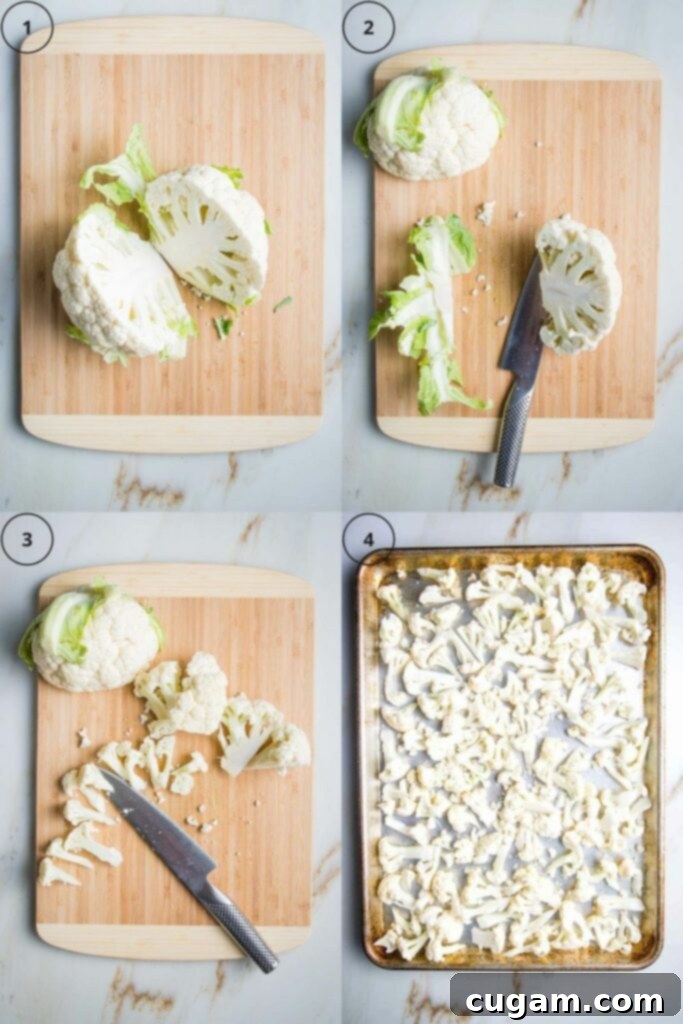
- Slice in Half: Place the cauliflower head stem-side down on your cutting board. Carefully cut it in half right down the center, slicing through the core. This gives you two stable halves to work with.
- Trim the Base: Take one half of the cauliflower. Using your knife, carefully trim off the tough bottom core and any attached green leaves. You can either discard these or save them for making vegetable broth. Repeat with the other half.
- Segment into Florets: With the cut-side down, begin to gently pry apart the natural divisions of the cauliflower. Use your knife to cut around the central stem of each large section, allowing the smaller “trees” (florets) to separate. Aim for florets that are roughly 1-2 inches in size for even cooking. You can always trim larger florets into smaller pieces if needed.
- Continue and Prepare: Keep working through both halves until all the cauliflower has been separated into small, individual florets. Once you have your florets, they are ready for your desired preparation! For example, place them on a sheet pan, drizzle with a generous amount of olive oil, and sprinkle your favorite spices (like the ones in our easy roasted cauliflower recipe below) and you’re ready to make delicious roasted cauliflower.
What to Serve with Cauliflower: Versatile Pairing Ideas
I always make sure to keep a head of cauliflower in my fridge. Its incredible versatility means I can use it in countless ways, which, in turn, opens up a world of possibilities for what to serve alongside it. Whether you’re making it a star or a supporting player, cauliflower pairs beautifully with a wide range of dishes. Here are some of my tastiest ideas to inspire your next meal:
- For a comforting and wholesome meal, a hearty vegan meatloaf is absolutely perfect when served with creamy mashed cauliflower, offering a rich flavor and a lighter alternative to traditional mashed potatoes.
- Looking for a robust, satisfying one-bowl meal? Dijon Lentils with Roasted Veggies is a flavorful vegan dish that stands alone beautifully, especially with the added texture and nutrients of roasted cauliflower. It’s truly a “one and done” solution for busy weeknights.
- Homemade roasted cauliflower hummus is a delightful, low-carb dip that’s best enjoyed with fresh crudités (like cucumber sticks, bell pepper strips, or carrot sticks) or generously spread on sandwiches and wraps. For a next-level flavor experience, try a generous shmear on a savory quinoa veggie burger or a hearty black bean burger – I promise, it’s incredibly delicious!
- If you’re baking, don’t miss out on making a batch of fluffy cauliflower onion rolls. These are wonderfully complemented by a homemade, naturally sweetened spread like simple orange chia marmalade for a sweet and savory contrast.
- When you’ve crafted a truly beautiful whole roasted cauliflower as your centerpiece, often all you need to balance the meal is a crisp and refreshing simple green salad, perhaps with a tangy vinaigrette.
- I particularly love this gorgeous raw cauliflower salad because it’s so flavorful and satisfying it can easily stand on its own as a light lunch. It also pairs exceptionally well with a chilled, vibrant gazpacho for a refreshing summer meal.
- For a truly fulfilling and flavorful dinner, Spiced Chickpea Stew + Veggies offers a complete and totally satisfying meal. And as a delightful end to your feast, I highly recommend serving up some rich and fudgy tahini brownies afterwards – you’re welcome!
Creamy & Comforting Vegan Cauliflower Soup Recipes
Cauliflower is a fantastic ingredient for creating incredibly creamy and flavorful soups, all without the need for any dairy. Its mild taste becomes wonderfully savory when cooked, and its natural starches provide a velvety texture that thickens soups beautifully. These recipes are designed to be delicious, comforting, and healthy, ensuring the taste of cauliflower enhances rather than overpowers the dish. Cauliflower truly is a whole foods ingredient and a smart choice for adding substance and creaminess to your favorite soups.
7. Cauliflower Soup with Red Lentils
Cauliflower Soup with Red Lentils
Cauliflower Soup with Red Lentils
8. Creamy Vegan Asparagus Soup
Creamy Vegan Asparagus Soup
Vegan Asparagus Soup Recipe
9. Chunky Roasted Veggie Soup
Chunky Roasted Veggie Soup
Chunky Roasted Veggie Soup Recipe
Cauliflower FAQs: Your Questions Answered
Cauliflower is a cruciferous vegetable belonging to the Brassica oleracea species, which also includes broccoli, cabbage, and kale. It’s characterized by its dense, edible white flower head, known as the “curd,” surrounded by thick green leaves. While white is the most common, cauliflower also comes in various vibrant colors like purple, yellow (often called orange), and green (like Romanesco, which has a distinctive spiraled, pointy floret structure). All parts of the cauliflower plant, including the leaves and stem, can be enjoyed, making it a highly versatile and nutritious addition to your diet. It can be prepared in numerous ways: enjoyed raw for a crisp texture, steamed gently, roasted to bring out its nutty sweetness, pureed for creamy dishes, mashed as a potato alternative, or riced as a grain substitute. Its adaptability allows it to be added to soups or stews for thickening, incorporated into salads for added texture, or even roasted whole as an impressive centerpiece for a vegan meal.
The shelf life of cauliflower varies depending on its form and how it’s stored. A fresh, whole head of cauliflower, when properly stored in the refrigerator in an unsealed plastic bag (perhaps with a paper towel to absorb moisture), can last surprisingly long – typically 1 to 2 weeks. For pre-cut or cauliflower rice, the shelf life is significantly shorter; fresh cauliflower rice will generally last 3-5 days in an airtight container in the fridge. To extend the life of cauliflower rice, it’s best to place it in a freezer-safe container or bag, where it can be stored for up to 2 months. Freezing is a great option for meal prepping and ensuring you always have some on hand.
Absolutely! Raw cauliflower is not only safe to eat but also delightful and incredibly nutritious. Its crisp texture and mild, slightly peppery flavor make it an excellent candidate for raw applications. You can enjoy raw cauliflower as part of a vibrant crudités platter, served alongside a healthy dip like hummus or a creamy tahini sauce. Alternatively, raw cauliflower can be finely chopped or thinly sliced and enjoyed as a crunchy component in a delicious raw cauliflower salad, offering a refreshing and satisfying crunch. Eating it raw preserves its maximum nutritional content, especially heat-sensitive vitamins like Vitamin C and certain beneficial enzymes.
Yes, absolutely! Cauliflower is an absolute staple for keto and low-carb diets due to its remarkably low carbohydrate content and incredible versatility. It contains significantly fewer net carbs than grains, potatoes, and even many other vegetables, making it an ideal substitute. On a keto diet, where carb intake is severely restricted, cauliflower can be transformed into “rice,” “mashed potatoes,” pizza crusts, or even “steaks,” allowing individuals to enjoy satisfying versions of their favorite high-carb foods while staying within their macro goals. Its mild flavor ensures it integrates seamlessly into almost any dish without overpowering other ingredients.
Yes, all parts of the cauliflower plant are edible and delicious! The leaves and stems are often discarded, but they are packed with nutrients and flavor. The tender inner leaves can be finely chopped and added to salads, stir-fries, or roasted alongside the florets. The thicker outer leaves and the main stem can be cooked similarly to cabbage or broccoli stems—chopped and added to soups, stews, sautés, or even roasted until tender. They offer a slightly stronger, more peppery flavor than the florets and contribute additional fiber and vitamins, reducing food waste and maximizing your culinary yield.
More Healthy and Inspiring Cauliflower Recipes
The versatility of cauliflower extends far beyond just rice and soup. Get ready to expand your culinary repertoire with these exciting and healthy cauliflower-focused recipes, showcasing just how incredible this vegetable can be!
10. Whole Roasted Cauliflower
Whole Roasted Cauliflower
Whole Roasted Cauliflower Recipe
11. Roasted Cauliflower Shawarma
Roasted Cauliflower Shawarma
Roasted Cauliflower Shawarma Recipe
12. Roasted Cauliflower Salad Recipe
Roasted Cauliflower Salad Recipe
Roasted Cauliflower Salad Recipe
13. Vegan Cauliflower Steak with Chimichurri Sauce
Vegan Cauliflower Steak with Chimichurri Sauce
Cauliflower Steaks with Chimichurri
14. Roasted Cauliflower Hummus
Roasted Cauliflower Hummus
Low Carb Roasted Cauliflower Hummus
15. Cauliflower Kugel
Cauliflower Kugel
Cauliflower Kugel Recipe
📖 Recipe: Easy Roasted Cauliflower
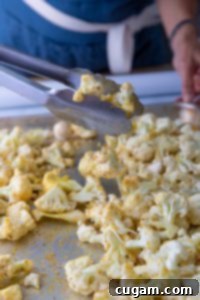
Easy Roasted Cauliflower Recipe
Debra Klein
Rate this Recipe
Pin Recipe
Equipment
-
13-piece Measuring Cups and Spoons Set, 18/8 Stainless Steel Heavy Duty Ergonomic Handle with Ring Connector
-
PRECISE CANADA: STAINLESS STEEL HEAVY BAKING SHEET
-
OXO Good Grips 12-Inch Stainless-Steel Locking Tongs
Ingredients
- 1 head cauliflower approximately 4 cups florets
- 2 Tablespoons olive oil
- ½ teaspoon coarse sea salt
- ½ teaspoon turmeric
- ½ teaspoon cumin
- ½ teaspoon paprika
- ¼ teaspoon ground black pepper
Instructions
-
Preheat your oven to a robust 425°F (220°C). This high temperature is key to achieving beautifully caramelized and tender roasted cauliflower.
-
PREPARE CAULIFLOWER: Begin by cutting the cauliflower head in half, slicing carefully down through the core. Next, trim off the bottom stem and any remaining tough leaves. Finally, cut the cauliflower into evenly sized florets, aiming for pieces roughly 1-2 inches each.
-
WASH CAULIFLOWER: Place the prepared florets into a large bowl filled with lightly salted water. This helps dislodge any small insects or impurities that might be tucked within the florets, causing them to float to the top. Let it soak for about a minute. Then, drain the cauliflower thoroughly and spread the florets on a clean kitchen towel or paper towels to dry completely. Excess moisture will steam the cauliflower instead of roasting it.
-
Arrange the dried cauliflower florets onto a rimmed baking tray. It’s crucial that the florets fit in a single layer without overcrowding for optimal roasting. If necessary, use two baking trays.
-
Drizzle the cauliflower evenly with olive oil. Mix thoroughly to ensure every floret is lightly coated. Then, sprinkle on the specified spices (coarse sea salt, turmeric, cumin, paprika, and ground black pepper) and mix again until the spices are evenly distributed. This is easiest done with your clean hands or a large pair of tongs.
-
Roast in the preheated oven for 20-25 minutes, or until the cauliflower florets are beautifully tender on the inside, crisp and slightly caramelized on the edges. A fork should easily pierce the thickest part of a floret. Serve immediately and enjoy!
Notes
Nutrition
Note
The nutrition calculations were done using online tools. To obtain the most accurate representation of the nutritional information in any given recipe, you should calculate the nutritional information with the actual ingredients you used. You are ultimately responsible for ensuring that any nutritional information is accurate, complete and useful.
Cauliflower is more than just a vegetable; it’s a culinary adventure waiting to happen. With its impressive health benefits and remarkable ability to adapt to nearly any flavor profile or cooking method, it truly deserves a place in every kitchen. From simple roasted florets to innovative grain-free alternatives and comforting soups, the possibilities are endless. We hope this guide has inspired you to explore the delicious world of cauliflower and incorporate this fantastic food into your meals more often. Happy cooking!
